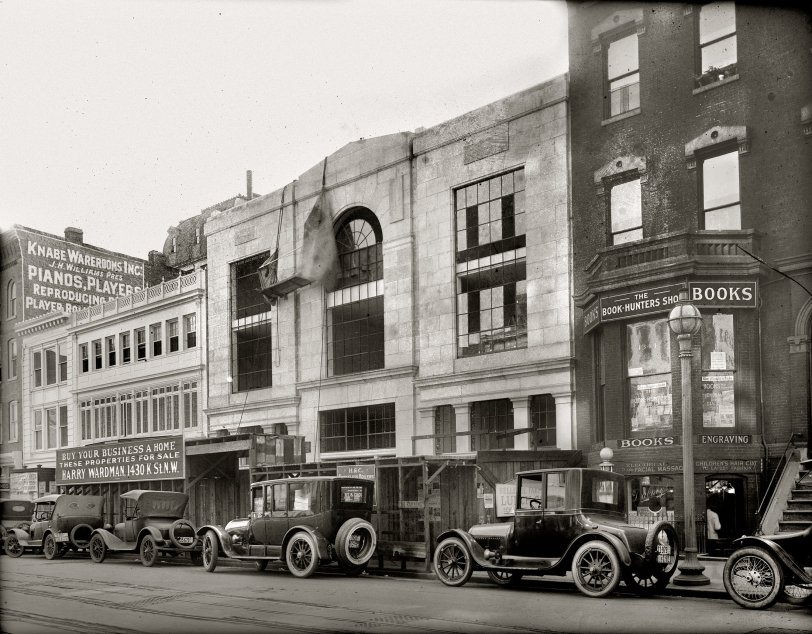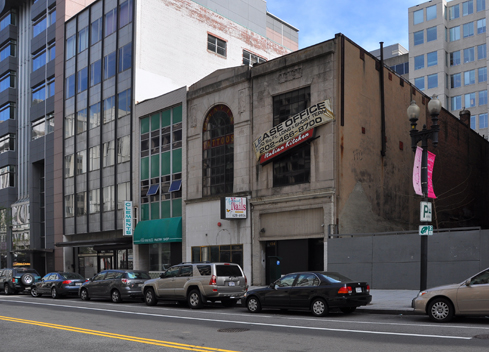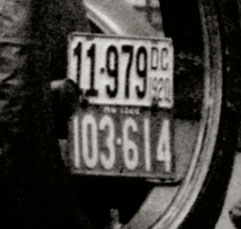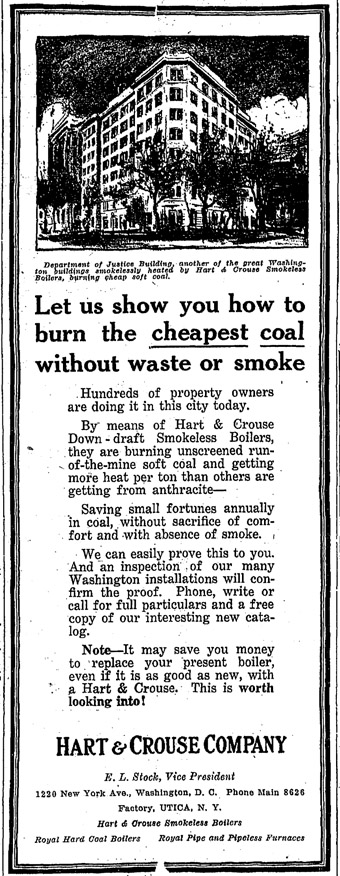


Framed or unframed, desk size to sofa size, printed by us in Arizona and Alabama since 2007. Explore now.
Shorpy is funded by you. Patreon contributors get an ad-free experience.
Learn more.

- Indiana Harbor Belt abides
- Freezing haze
- Corrections (for those who care)
- C&NW at Nelson
- Fallen Flags
- A dangerous job made worse
- Water Stop
- Passenger trains have right of way over freights?
- Coal
- Never ceases to amaze me.
- Still chuggin' (in model form)
- Great shot
- Westerly Breeze
- For the men, a trapeze
- Tickled
- Sense of loneliness ...
- 2 cents
- Charm City
- What an Outrage
- Brighton Park
- Catenary Supports
- Just a Little Before I was Born
- Afternoon normal
- The Flat Iron Cafe survives
- Aging in Place
- Raise your hand
- Good and Bad
- Oh, the 70's
- Nooooooi
- The aluminum tubing
Print Emporium
Words and Music: 1920

Washington, D.C., circa 1920. "Harry Wardman property, 1340 G Street." National Photo Company Collection glass negative. View full size.
Now gone
An update: These buildings have been demolished. The D.C. government threatened to declare them a blight and gave the owners a deadline to demolish them, otherwise the property taxes would have increased dramatically. The demolition began a bit before Christmas and seems to have mostly wrapped up over the past MLK holiday weekend (Jan. 18-20). Here's a WBJ story from last year about the fate of the buildings:
http://www.bizjournals.com/washington/breaking_ground/2013/04/dc-buildin...
+90
As edition_of_one noted with the Google Street View, two of the buildings still exist although they are still vacant and have been for several years. Prospects for tenants aren't great. Below is the identical view taken in April of 2010.

Still there
I work across the street from those buildings. They've been abandoned for approx 7 years (most recently they were the site of an adult bookstore/tattooist and palm reader). The bookstore building has been gone longer than that and is just a deep hole now. Just last week they've started to clean up the empty site of the bookstore, to make way for a new building which will be part of the Armenian Holocaust Museum being built there and in the old National Bank next door on the corner.
That's not the Willard in the background. The Willard is off the right side of the picture, 1 block down.
This stretch of G Street between 13th and 14th is one of the last "underdeveloped" areas downtown. Looking forward to some of the luster coming back.
Autumn 1920
I am always curious when Dave states something such as "circa 1920." To what extent is such a statement based on information attached to the photo and to what degree is it based on Dave's own research and intuition?
In this case, Dave, is indeed, quite accurate. I date the photo to Autumn of 1920, bracketed by the following Washington Post articles:
- Sep 26, 1920: Bellevue Farms Lunch (located behind the photographed construction signage) at 1334-1336 G st, had acquired #1332 G street and the premises were being remodeled to serve as the "Bellevue Annex, Dining and Tea Room," (matches signage seen in photo)
- Dec 13, 1920: Advertisement announcing beauty services at Maison La Vigne, recently opened by Beatrix La Vigne Erly at 1342 G St. (this address still under construction in photo)
- Jan 8, 1921: Bellevue Farms Lunch advertised that the former annex at 1332 G street is now functioning as "The Bellevue Bantam," a home style dining room serving "the same delicious Bellevue food." (signage in photo not yet updated reflect this name)
[The year is on the license plates. If the numbers aren't legible, you can often tell by the design. - Dave]

The Young Visiters
"The Young Visiters" was written by Daisy Ashford when she was 9 years old (though not published until some years later).
The full text is available at project Gutenberg.
No Parking
I wonder how much a parking ticket was back then?
John Dabney: Barber to Presidents.
The ground floor barber shop at 1344 G appears to have been the business of semi-famous barber John W. Dabney. A 1901 article regarding his hair tending activities is below: Dabney's clientele list is a who's who of the day's prominent politicians. I find the news article additionally interesting for the details of President McKinley's grooming regimen.
I believe (but can't be positive) that the owner of "Dabney's" in this photo to be the same person based on two additional factoids:
- The Post's legal notices, Jun 5, 1913, include reference to "John W. Dabney, 1344 G Sts. N.W."
- Census records list only one John W. Dabney in the relevant period. The 1920 census cites him living at 618 R St, age 63, mulatto, born in Virginia, occupation: barber, owns his own shop.
He Shaves Great Men
Barber Whose Razor Moves Over Familiar Faces.
Over a little shop in an F street basement there presides a man who has perhaps pulled the noses of more distinguished men than any other man in the country. Withal he has pulled them gently, and has for years been a great favorite of men who have thus been assailed by him. He is John W. Dabney, a colored barber, who is the special barber of the President of the United States and of two score of other public men, who compelled to be shaved like ordinary mortals, delight in having that duty well done and with due regard to their own comfort and convenience.
There are three sets of official barbers in Washington, the Executive, the Senate, and the House of Representatives, but the dean of this corps is, or course, the man who shaves the President, looks after his hair, and keeps the Executive scalp in good condition. Dabney is an artist in this line, and one of the most modest of men. He is not talkative. He has never yet contracted the failing of the average barber, and no man who wished to sleep would be kept awake while under his care.
It must not be inferred, however, that President McKinley does not know how to handle a razor. He has all the accomplishments that belong to the first gentleman of the land, and shaves himself every morning. Dabney is an occasional visitor only, and he becomes the official barber when the President's hair needs trimming and when his scalp demands attention. This occurs about once a week. There is a barber's chair at the White House, but is has fallen into disuse. The President sits in an ordinary easy chair while Dabney spends the hour and a half usually required to properly dress Mr. McKinley's head and shave him. The Presidential face is somewhat tender and demands some care. His beard grow "stout" and must be handled gingerly. In the chair the President is one of the most pleasant of men. He talks freely and discusses current matters of the day, save politics. That he carefully eschews. He enjoys the operation, chats entertainingly, and after his head has been rubbed and scalp treated, as Dabney only knows how to treat it, the President expresses his satisfaction, and goes about his arduous duties refreshed and contented.
Then Dabney returns to his shop and waits on ordinary mortals or makes the rounds of the houses where he is daily expected in his duties and require him to care for the hair of ladies of innumerable official families. He is, as a barber, one of the most familiar figures in many of the leading families in Washington. For thirty years he has wielded the scissors and razor, and twenty-three years of that time has been spent in Washington. Among those now living whom he has or is servicing are, besides the President and Mrs. McKinley, Secretary Root, Secretary Long, Vice President-elect Roosevelt, Senator Frye, former Vice-President Stevenson, Justice Harlan, Gen. Miles, Admiral Dewey, Senator Hoar, Senator Carter, Gen. Clarkson, Henry Watterson, Gen. Tracy, former Secretary of the Navy, former Senators Murphy and Smith, and others.
Among the distinguished dead who were habitues of his shop were James G. Blaine, Secretary of State; W. W. Corcoran, philanthropist; Secretary Windom, of the Treasury; Secretary of Agricultural Rusk, Senator Farley, of California; Senator Vorhees, of Indiana, and many others. ...
Discussing the habits of great men in the chair, Dabney said: "Mr. Roosevelt was always chatty. He discussed anything that happened to be the center of public attraction, politics, prize fights, sports, religion, or anything that people were talking and thinking about. Blaine and Corcoran were reticent. They had little to day, but were always pleasant. The German and French ministers like their own peculiar foreign hair cuts, expressed the satisfaction when well served, but did no talking. Secretary Root likes good attention, is pleasant and agreeable, but reserved. Secretary Long is a man of few words at all times, and fewer still when in the barber's chair. Former Vice President Stevenson had a pleasant word whenever he entered the shop, took everything good naturedly, and was easily pleased. Few men are testy when under the scissors or razor, in you only study what they like and endeavor to give it to them."
Since his appointment as the White House barber three years ago, Dabney has had many calls, not only for prominent officials but from many ladies, wives, of Cabinet officers, and others in Congressional and exclusive social circles, whom he attended for hair and scalp treatment. One interesting thing in connection with his work is the fact that he has been of student of his profession and refuses to use any of the numerous so called remedies for the scalp with which the market is flooded. He uses his own shampoos, tonics, &c., which are compounded by himself. This secret, whatever it is, is zealously guarded by him, but he proudly asserts that the ladies of Washington society whom he treats regularly and whose hair he keeps in order commend him for the excellence of his work. As a successor to Charles Leamis, who has been identified with the White House since Grant's first term, Dabney seems to have been succesful and to have won the favor of those with whom he comes in contact.
...
[article goes on to detail barbers of the House and Senate]Washington Post, Feb 3, 1901
also appeared in The Colored American, Jun 29, 1901
Dabney's
Harry Wardman
Indication is, Harry lost his fortune in the 1929 Wall Street crash. He had amassed $30 million. Wouldn't a lot of it be in his vast real estate empire? That would also have been depressed, but not like the stock market.
Electrical Massage?
Dabney's, under the bookstore, is apparently offering "Electrical Scalp and Facial Massages." YOW!
You know, I love these old photos because, often as not, they remind us of how much we have in common with the people in them, in spite of the funny technology and hairdos.
This is NOT such a time. Electrical Face Massage? They... run 120V through your face?
I hope that I'm just ignorant of the process.
Wutta View!
Shame about the "facadomy" applied to the face of this building over the years. The original architecture was handsome and robust. Trivia: I believe that's the roof of the Willard Hotel (14th & F Streets N.W.) appearing to the upper left of the subject building. The sign announcing the "smokeless boilers" may refer to the site's having natural gas service to supplant coal use-- the "smokeless" feature can be thought of as an antecedent to today's "green" technology. The streetcar tracks seen here belonged at the time to the Washington Railway & Electric Company, later becoming the Capital Transit Co.'s Route 20 line, which covered a LOT of territory from Bladensburg, Md., in the east of Washington to Cabin John, near Great Falls to the west of the city. The "No Parking" sign was not taken seriously, if only because of its homemade look.
["Smokeless" generally meant coal-fired downdraft boilers. - Dave]

Double Jeopardy
Four of the five cars with visible license plates have 2 plates. One plate on each car is D.C. Can anyone know what the other one was and why the cars had two?
[Those are Maryland plates. In the days before motor vehicle reciprocity, a driver might need to have a license plate for every jurisdiction he drove in. - Dave]
Still waiting
It looks like it's still for lease (or at least part of it) after 88 years ...
























On Shorpy:
Today’s Top 5